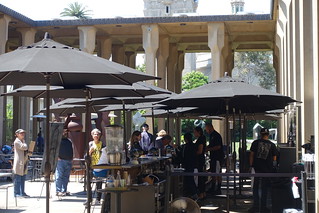Last week, I spoke at, and attended, Madworld 2016, the conference hosted by MadCap Software for its users. It’s the most rewarding and enjoyable of all the conferences on technical communication that I attend. Here is a summary of what I saw and heard on the first day.
A sneak peek at MadCap Central
MadCap doesn’t normally pre-announce new software, but this year they broke their rule and provided a preview of MadCap Central.

Central is an application for managing Help projects. It is a Cloud-based project and team management application that contains a Trello-like kanban board and calendar for scheduling tasks and managing deadlines. It also provides build (aka publishing) management and translation management in the Cloud. There is also an administration area for managing users and user licences. Central looks to have functionality similar to GatherContent, a project management tool used by content strategists, although without an explicit workflow. Please note, you would still use MadCap Flare and Contributor for authoring and editing content.
Its main audience will be organisations that have a team of writers using Flare at different geographical locations, and who want to reduce the internal IT burden by using a Cloud-based management solution.
CSS Flexbox Layout
I didn’t see this presentation, but Matthew Ellison’s introduction to this W3C Working Draft standard was mentioned by a number of delegates. Flexbox aims to provide a more efficient way to lay out, align, and distribute space among items in a container. It creates intelligent boxes that are stretchable, squeezable and capable of changing visual order.

Integrating API Reference Documentation with MadCap Flare
Andrei Essaoulov of kCura presented a case study on integrating Sandcastle-generated .NET API reference HTML pages into a developers’ documentation site authored in MadCap Flare. Integrating automatically-generated reference content with other information needed by users is a challenge for many organisations. In kCura’s case, they have to document several .NET APIs; this means they have to integrate thousands of pages of API reference and create a common documentation experience.

Most of the heavy lifting was automated, using Jenkins builds and PowerShell scripts. Andrei outlined what he called “a few kludges” to import the Sandcastle-generated content; these included importing a .CHM file generated automatically from Sandcastle into Flare, and using an empty topic to reference Sandcastle content via an iframe. The reasons for using Flare were the ability to single source content, publish content as PDFs, provide faceted and filtered search options, and include local Table of Contents on the right hand side of the topics. Flare also offered hyperlink management, and a better search engine.
Managing Training Courses in MadCap Flare
Mio Kataoka’s presented a case study on how she had used Flare to replace AppDynamics’s outdated system for creating training courseware, and implement HTML5 classroom presentations, student eBooks and PDF lab guides. Previously, it was costing AppDynamics $12 per student to produce their course materials. Also, four courses contained 90% identical content. Moving to Flare meant this content could be written and managed in one place, and then used in the four courses and the two platform variations. It also meant they could ensure the courses were being presented consistently, eliminating the situations where rogue instructors might be changing the content.
It was interesting to learn about how they had moved away from printed materials for students, and to an online format instead. This meant video content could be integrated into the course notes and they could update the notes in the future. The ability for students to make notes was raised by the audience; a future enhancement might be to add the ability to annotate the online course notes. The instructor presentations contained a link to a Google Docs document that contained notes for the instructors.
One of the attractions of Keynote and PowerPoint is they encourage you to use a lot of visual information. By moving to Flare, you would need to check you were still using enough visual content in your slides.
Using MadCap Flare in an Agile SDLC
The last presentation I saw on Monday was eBay Enterprises’ Robert Hays, who recommended some ways of working within an Agile environment. Robert treats documentation as code, and documentation activities as Agile tasks. His and the authoring team’s role is that of a developer (of content). Reviews and edits are called “calibrations” and “defects”, and the technical publishing team use the same tools as the developers, wherever possible.
He said content needs a definition of “Done”, like the other activities in an Agile project, and work should be structured in eight hour work plans similar to the developers’ work plans. The User Stories should used to generate one or more topics: conceptual topics, task-based topics or reference topics. Robert includes the feature number and the User Story reference number in the topic titles, so there is close tracking of topics to code development.
The attraction of this approach is that it integrates the documentation development with the code development. Content is scheduled, reviewed, corrected and approved in the same way as the code.
What Content Strategists Can Teach Us About Promoting the Value of Content
This was the first of my two presentations at the conference. In both presentations, I was delighted to see the room was packed. I talked about what technical communicators can learn from content strategists when it comes to promoting their services. It was interesting putting together the presentation, as I realised we often forget to do some of the things that seem to come naturally to content strategists. One simple example being to declare victory at the end of the project!
Summary
The case studies on Day One showed that Flare is a tool with a lot of capabilities. I’ll review the second day in another post.


Terrific overview. Thanks for all the tech details on presentations
Thank you Maxwell